Abstract
By using an expression cloning strategy, we isolated a single positive clone encoding a tilapia prolactin (PRL) receptor. Tilapia PRL188 was used to screen a freshwater tilapia kidney expression library transfected in COS cells. The tilapia PRL receptor is a mature protein of 606 amino acids. The extracellular domain is devoid of the tandem repeat units present in birds and has two pairs of cysteine residues, a Trp-Ser-Xaa-Trp-Ser motif, and two potential N-glycosylation sites. The cytoplasmic domain contains 372 amino acids, including box 1, a sequence previously shown to be important for signal transduction in mammalian species. Thus, the general structure is similar to the long form of mammalian PRL receptors; however, amino acid comparisons reveal a rather low identity (approximately 37%). Northern blot analysis shows the existence of a single transcript in osmoregulatory tissues and reproductive organs. This localization is in agreement with known functions of PRL in teleosts.
Full text
PDF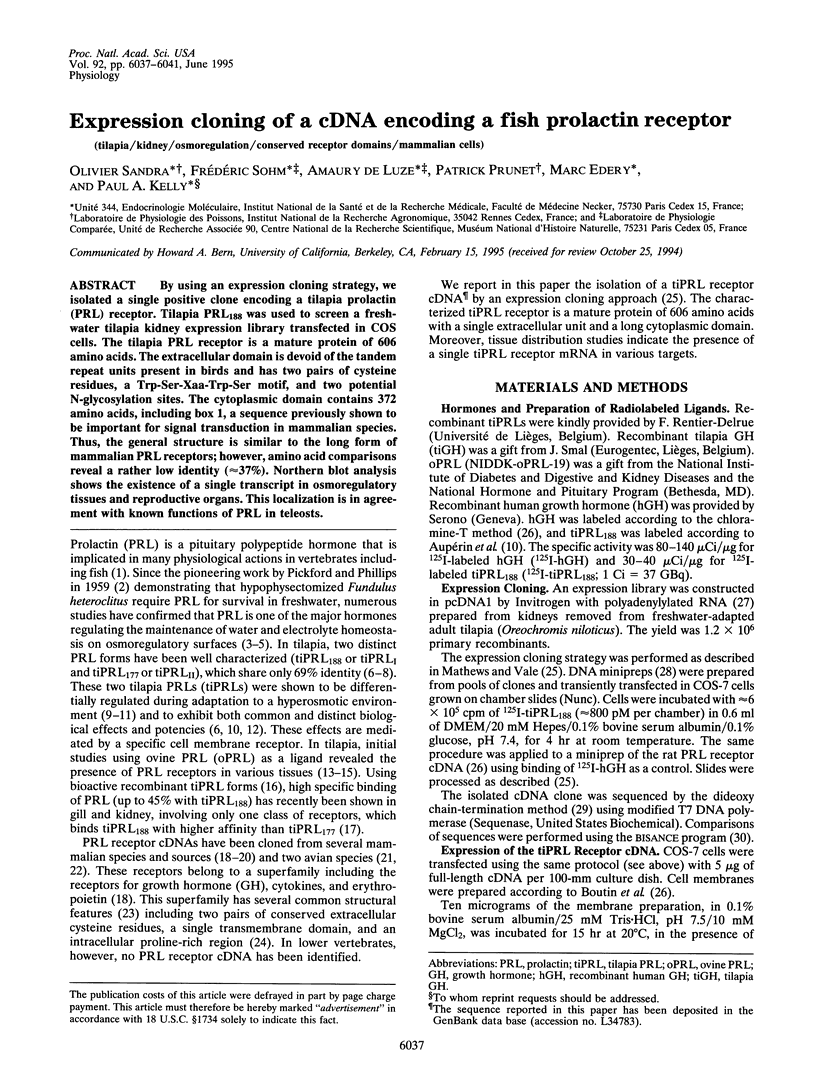
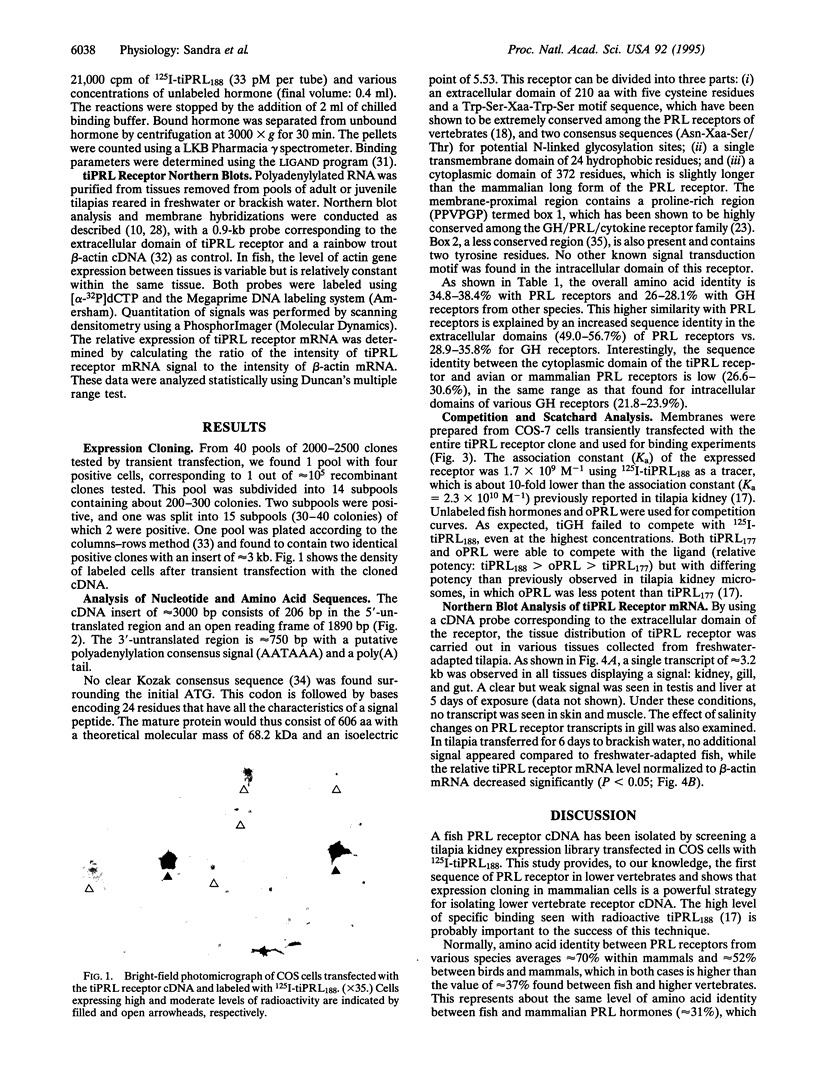
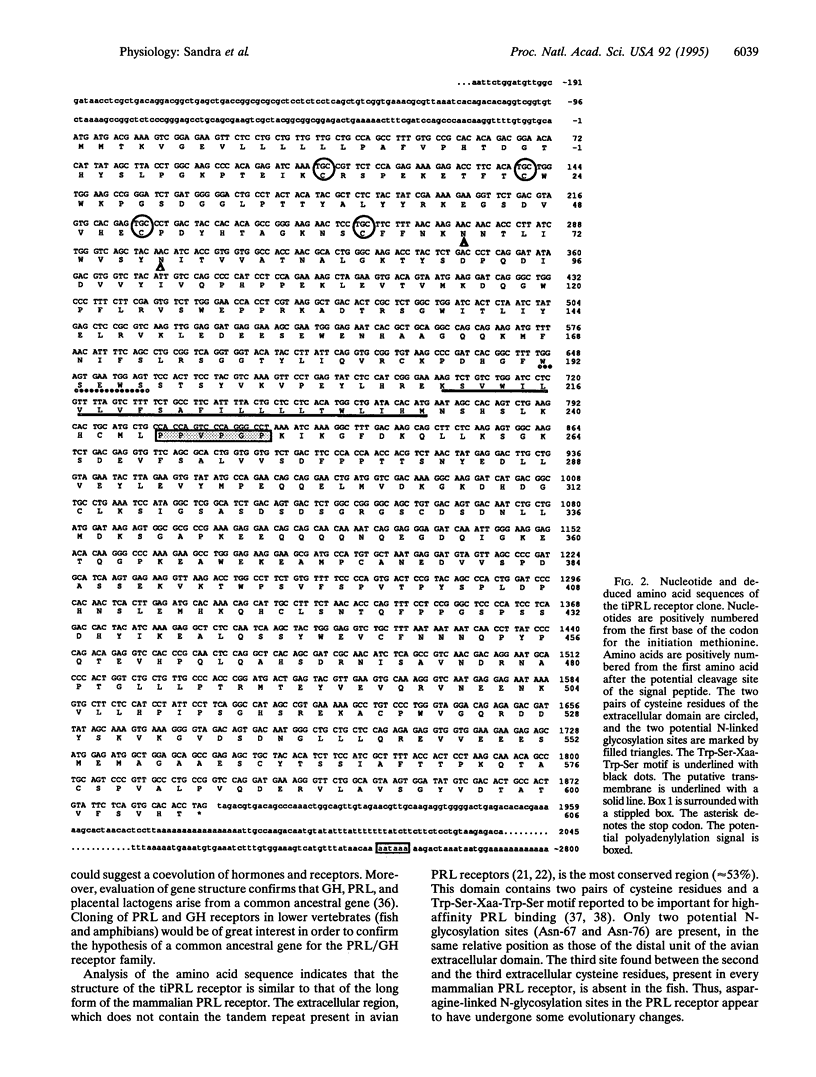
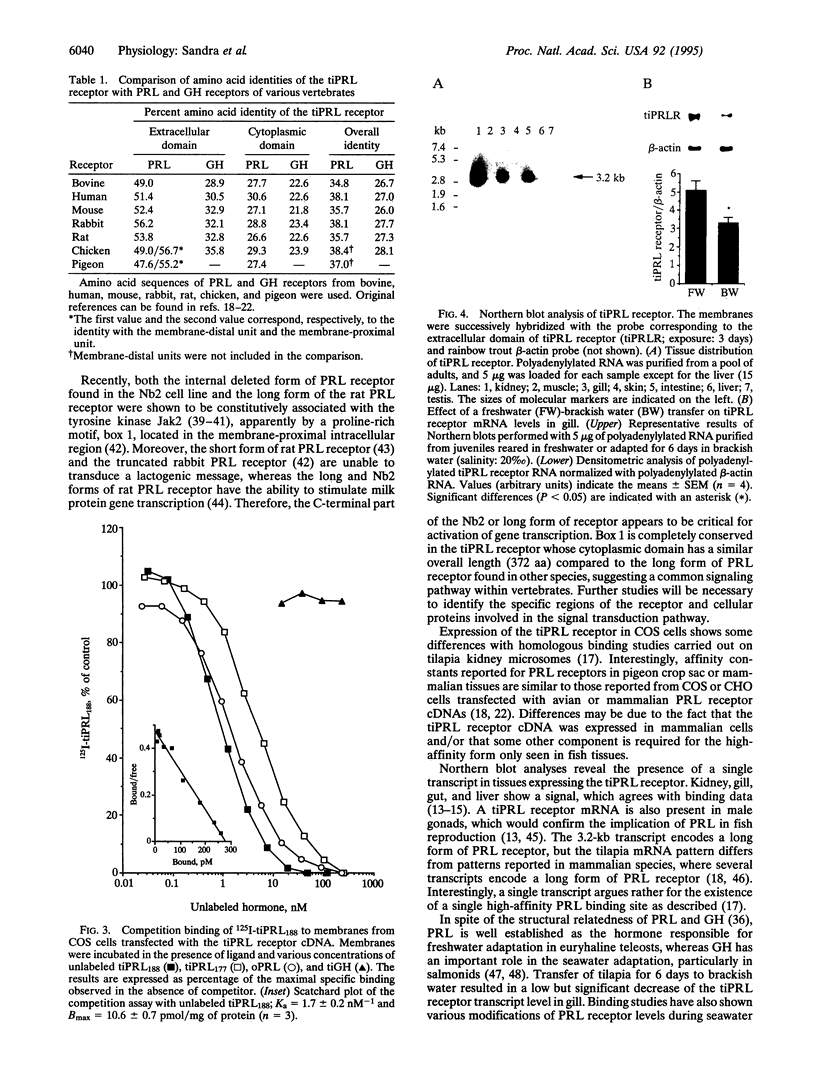
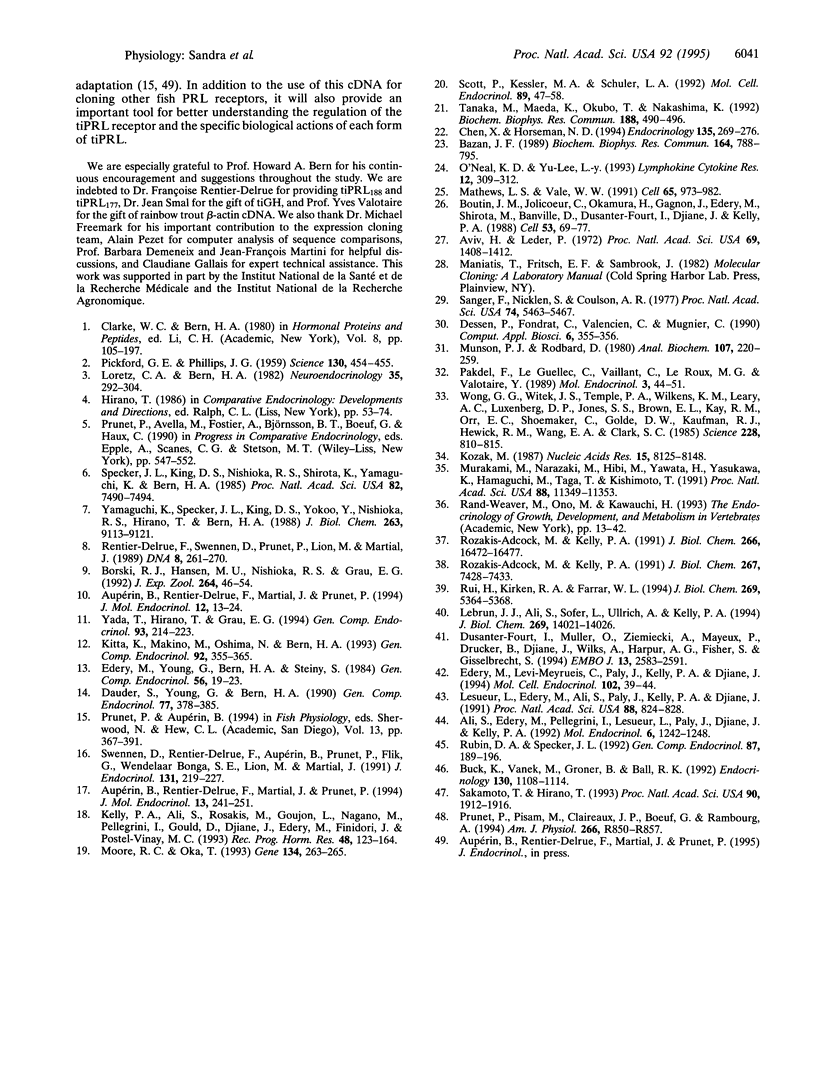
Images in this article
Selected References
These references are in PubMed. This may not be the complete list of references from this article.
- Ali S., Edery M., Pellegrini I., Lesueur L., Paly J., Djiane J., Kelly P. A. The Nb2 form of prolactin receptor is able to activate a milk protein gene promoter. Mol Endocrinol. 1992 Aug;6(8):1242–1248. doi: 10.1210/mend.6.8.1406702. [DOI] [PubMed] [Google Scholar]
- Auperin B., Rentier-Delrue F., Martial J. A., Prunet P. Characterization of a single prolactin (PRL) receptor in tilapia (Oreochromis niloticus) which binds both PRLI and PRLII. J Mol Endocrinol. 1994 Dec;13(3):241–251. doi: 10.1677/jme.0.0130241. [DOI] [PubMed] [Google Scholar]
- Auperin B., Rentier-Delrue F., Martial J. A., Prunet P. Evidence that two tilapia (Oreochromis niloticus) prolactins have different osmoregulatory functions during adaptation to a hyperosmotic environment. J Mol Endocrinol. 1994 Feb;12(1):13–24. doi: 10.1677/jme.0.0120013. [DOI] [PubMed] [Google Scholar]
- Aviv H., Leder P. Purification of biologically active globin messenger RNA by chromatography on oligothymidylic acid-cellulose. Proc Natl Acad Sci U S A. 1972 Jun;69(6):1408–1412. doi: 10.1073/pnas.69.6.1408. [DOI] [PMC free article] [PubMed] [Google Scholar]
- Bazan J. F. A novel family of growth factor receptors: a common binding domain in the growth hormone, prolactin, erythropoietin and IL-6 receptors, and the p75 IL-2 receptor beta-chain. Biochem Biophys Res Commun. 1989 Oct 31;164(2):788–795. doi: 10.1016/0006-291x(89)91528-3. [DOI] [PubMed] [Google Scholar]
- Boutin J. M., Jolicoeur C., Okamura H., Gagnon J., Edery M., Shirota M., Banville D., Dusanter-Fourt I., Djiane J., Kelly P. A. Cloning and expression of the rat prolactin receptor, a member of the growth hormone/prolactin receptor gene family. Cell. 1988 Apr 8;53(1):69–77. doi: 10.1016/0092-8674(88)90488-6. [DOI] [PubMed] [Google Scholar]
- Buck K., Vanek M., Groner B., Ball R. K. Multiple forms of prolactin receptor messenger ribonucleic acid are specifically expressed and regulated in murine tissues and the mammary cell line HC11. Endocrinology. 1992 Mar;130(3):1108–1114. doi: 10.1210/endo.130.3.1537278. [DOI] [PubMed] [Google Scholar]
- Chen X., Horseman N. D. Cloning, expression, and mutational analysis of the pigeon prolactin receptor. Endocrinology. 1994 Jul;135(1):269–276. doi: 10.1210/endo.135.1.7516866. [DOI] [PubMed] [Google Scholar]
- Dauder S., Young G., Bern H. A. Effect of hypophysectomy, replacement therapy with ovine prolactin, and cortisol and triiodothyronine treatment on prolactin receptors of the tilapia (Oreochromis mossambicus). Gen Comp Endocrinol. 1990 Mar;77(3):378–385. doi: 10.1016/0016-6480(90)90227-d. [DOI] [PubMed] [Google Scholar]
- Dessen P., Fondrat C., Valencien C., Mugnier C. BISANCE: a French service for access to biomolecular sequence databases. Comput Appl Biosci. 1990 Oct;6(4):355–356. doi: 10.1093/bioinformatics/6.4.355. [DOI] [PubMed] [Google Scholar]
- Dusanter-Fourt I., Muller O., Ziemiecki A., Mayeux P., Drucker B., Djiane J., Wilks A., Harpur A. G., Fischer S., Gisselbrecht S. Identification of JAK protein tyrosine kinases as signaling molecules for prolactin. Functional analysis of prolactin receptor and prolactin-erythropoietin receptor chimera expressed in lymphoid cells. EMBO J. 1994 Jun 1;13(11):2583–2591. doi: 10.1002/j.1460-2075.1994.tb06548.x. [DOI] [PMC free article] [PubMed] [Google Scholar]
- Edery M., Levi-Meyrueis C., Paly J., Kelly P. A., Djiane J. A limited cytoplasmic region of the prolactin receptor critical for signal transduction. Mol Cell Endocrinol. 1994 Jun;102(1-2):39–44. doi: 10.1016/0303-7207(94)90095-7. [DOI] [PubMed] [Google Scholar]
- Edery M., Young G., Bern H. A., Steiny S. Prolactin receptors in tilapia (Sarotherodon mossambicus) tissues: binding studies using 125I-labeled ovine prolactin. Gen Comp Endocrinol. 1984 Oct;56(1):19–23. doi: 10.1016/0016-6480(84)90056-x. [DOI] [PubMed] [Google Scholar]
- Kelly P. A., Ali S., Rozakis M., Goujon L., Nagano M., Pellegrini I., Gould D., Djiane J., Edery M., Finidori J. The growth hormone/prolactin receptor family. Recent Prog Horm Res. 1993;48:123–164. doi: 10.1016/b978-0-12-571148-7.50009-9. [DOI] [PubMed] [Google Scholar]
- Kitta K., Makino M., Oshima N., Bern H. A. Effects of prolactins on the chromatophores of the tilapia, Oreochromis niloticus. Gen Comp Endocrinol. 1993 Dec;92(3):355–365. doi: 10.1006/gcen.1993.1173. [DOI] [PubMed] [Google Scholar]
- Kozak M. An analysis of 5'-noncoding sequences from 699 vertebrate messenger RNAs. Nucleic Acids Res. 1987 Oct 26;15(20):8125–8148. doi: 10.1093/nar/15.20.8125. [DOI] [PMC free article] [PubMed] [Google Scholar]
- Lebrun J. J., Ali S., Sofer L., Ullrich A., Kelly P. A. Prolactin-induced proliferation of Nb2 cells involves tyrosine phosphorylation of the prolactin receptor and its associated tyrosine kinase JAK2. J Biol Chem. 1994 May 13;269(19):14021–14026. [PubMed] [Google Scholar]
- Lesueur L., Edery M., Ali S., Paly J., Kelly P. A., Djiane J. Comparison of long and short forms of the prolactin receptor on prolactin-induced milk protein gene transcription. Proc Natl Acad Sci U S A. 1991 Feb 1;88(3):824–828. doi: 10.1073/pnas.88.3.824. [DOI] [PMC free article] [PubMed] [Google Scholar]
- Loretz C. A., Bern H. A. Prolactin and osmoregulation in vertebrates. An update. Neuroendocrinology. 1982 Oct;35(4):292–304. doi: 10.1159/000123397. [DOI] [PubMed] [Google Scholar]
- Mathews L. S., Vale W. W. Expression cloning of an activin receptor, a predicted transmembrane serine kinase. Cell. 1991 Jun 14;65(6):973–982. doi: 10.1016/0092-8674(91)90549-e. [DOI] [PubMed] [Google Scholar]
- Moore R. C., Oka T. Cloning and sequencing of the cDNA encoding the murine mammary gland long-form prolactin receptor. Gene. 1993 Dec 8;134(2):263–265. doi: 10.1016/0378-1119(93)90104-b. [DOI] [PubMed] [Google Scholar]
- Munson P. J., Rodbard D. Ligand: a versatile computerized approach for characterization of ligand-binding systems. Anal Biochem. 1980 Sep 1;107(1):220–239. doi: 10.1016/0003-2697(80)90515-1. [DOI] [PubMed] [Google Scholar]
- Murakami M., Narazaki M., Hibi M., Yawata H., Yasukawa K., Hamaguchi M., Taga T., Kishimoto T. Critical cytoplasmic region of the interleukin 6 signal transducer gp130 is conserved in the cytokine receptor family. Proc Natl Acad Sci U S A. 1991 Dec 15;88(24):11349–11353. doi: 10.1073/pnas.88.24.11349. [DOI] [PMC free article] [PubMed] [Google Scholar]
- O'Neal K. D., Yu-Lee L. Y. The proline-rich motif (PRM): a novel feature of the cytokine/hematopoietin receptor superfamily. Lymphokine Cytokine Res. 1993 Oct;12(5):309–312. [PubMed] [Google Scholar]
- PICKFORD G. E., PHILLIPS J. G. Prolactin, a factor in promoting survival of hypophysectomized killifish in fresh water. Science. 1959 Aug 21;130(3373):454–455. doi: 10.1126/science.130.3373.454. [DOI] [PubMed] [Google Scholar]
- Pakdel F., Le Guellec C., Vaillant C., Le Roux M. G., Valotaire Y. Identification and estrogen induction of two estrogen receptors (ER) messenger ribonucleic acids in the rainbow trout liver: sequence homology with other ERs. Mol Endocrinol. 1989 Jan;3(1):44–51. doi: 10.1210/mend-3-1-44. [DOI] [PubMed] [Google Scholar]
- Prunet P., Avella M., Fostier A., Björnsson B. T., Boeuf G., Haux C. Roles of prolactin in salmonids. Prog Clin Biol Res. 1990;342:547–552. [PubMed] [Google Scholar]
- Prunet P., Pisam M., Claireaux J. P., Boeuf G., Rambourg A. Effects of growth hormone on gill chloride cells in juvenile Atlantic salmon (Salmo salar). Am J Physiol. 1994 Mar;266(3 Pt 2):R850–R857. doi: 10.1152/ajpregu.1994.266.3.R850. [DOI] [PubMed] [Google Scholar]
- Rentier-Delrue F., Swennen D., Prunet P., Lion M., Martial J. A. Tilapia prolactin: molecular cloning of two cDNAs and expression in Escherichia coli. DNA. 1989 May;8(4):261–270. doi: 10.1089/dna.1.1989.8.261. [DOI] [PubMed] [Google Scholar]
- Rozakis-Adcock M., Kelly P. A. Identification of ligand binding determinants of the prolactin receptor. J Biol Chem. 1992 Apr 15;267(11):7428–7433. [PubMed] [Google Scholar]
- Rozakis-Adcock M., Kelly P. A. Mutational analysis of the ligand-binding domain of the prolactin receptor. J Biol Chem. 1991 Sep 5;266(25):16472–16477. [PubMed] [Google Scholar]
- Rubin D. A., Specker J. L. In vitro effects of homologous prolactins on testosterone production by testes of tilapia (Oreochromis mossambicus). Gen Comp Endocrinol. 1992 Aug;87(2):189–196. doi: 10.1016/0016-6480(92)90022-c. [DOI] [PubMed] [Google Scholar]
- Rui H., Kirken R. A., Farrar W. L. Activation of receptor-associated tyrosine kinase JAK2 by prolactin. J Biol Chem. 1994 Feb 18;269(7):5364–5368. [PubMed] [Google Scholar]
- Sakamoto T., Hirano T. Expression of insulin-like growth factor I gene in osmoregulatory organs during seawater adaptation of the salmonid fish: possible mode of osmoregulatory action of growth hormone. Proc Natl Acad Sci U S A. 1993 Mar 1;90(5):1912–1916. doi: 10.1073/pnas.90.5.1912. [DOI] [PMC free article] [PubMed] [Google Scholar]
- Sanger F., Nicklen S., Coulson A. R. DNA sequencing with chain-terminating inhibitors. Proc Natl Acad Sci U S A. 1977 Dec;74(12):5463–5467. doi: 10.1073/pnas.74.12.5463. [DOI] [PMC free article] [PubMed] [Google Scholar]
- Scott P., Kessler M. A., Schuler L. A. Molecular cloning of the bovine prolactin receptor and distribution of prolactin and growth hormone receptor transcripts in fetal and utero-placental tissues. Mol Cell Endocrinol. 1992 Nov;89(1-2):47–58. doi: 10.1016/0303-7207(92)90210-w. [DOI] [PubMed] [Google Scholar]
- Specker J. L., King D. S., Nishioka R. S., Shirahata K., Yamaguchi K., Bern H. A. Isolation and partial characterization of a pair of prolactins released in vitro by the pituitary of a cichlid fish, Oreochromis mossambicus. Proc Natl Acad Sci U S A. 1985 Nov;82(22):7490–7494. doi: 10.1073/pnas.82.22.7490. [DOI] [PMC free article] [PubMed] [Google Scholar]
- Swennen D., Rentier-Delrue F., Auperin B., Prunet P., Flik G., Wendelaar Bonga S. E., Lion M., Martial J. A. Production and purification of biologically active recombinant tilapia (Oreochromis niloticus) prolactins. J Endocrinol. 1991 Nov;131(2):219–227. doi: 10.1677/joe.0.1310219. [DOI] [PubMed] [Google Scholar]
- Tanaka M., Maeda K., Okubo T., Nakashima K. Double antenna structure of chicken prolactin receptor deduced from the cDNA sequence. Biochem Biophys Res Commun. 1992 Oct 30;188(2):490–496. doi: 10.1016/0006-291x(92)91082-2. [DOI] [PubMed] [Google Scholar]
- Wong G. G., Witek J. S., Temple P. A., Wilkens K. M., Leary A. C., Luxenberg D. P., Jones S. S., Brown E. L., Kay R. M., Orr E. C. Human GM-CSF: molecular cloning of the complementary DNA and purification of the natural and recombinant proteins. Science. 1985 May 17;228(4701):810–815. doi: 10.1126/science.3923623. [DOI] [PubMed] [Google Scholar]
- Yada T., Hirano T., Grau E. G. Changes in plasma levels of the two prolactins and growth hormone during adaptation to different salinities in the euryhaline tilapia, Oreochromis mossambicus. Gen Comp Endocrinol. 1994 Feb;93(2):214–223. doi: 10.1006/gcen.1994.1025. [DOI] [PubMed] [Google Scholar]
- Yamaguchi K., Specker J. L., King D. S., Yokoo Y., Nishioka R. S., Hirano T., Bern H. A. Complete amino acid sequences of a pair of fish (tilapia) prolactins, tPRL177 and tPRL188. J Biol Chem. 1988 Jul 5;263(19):9113–9121. [PubMed] [Google Scholar]




